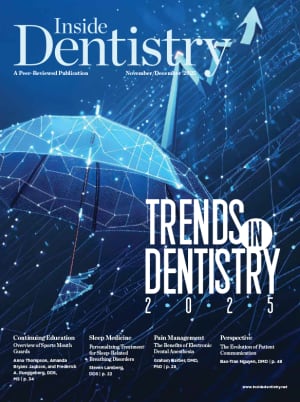Reaching an Understanding
In the past, we could say that our dentistry was only as good as the materials that we used. Things are a lot different today. Although material selection is still just as essential to successful outcomes, with the sheer number of materials available and how nuanced their protocols have become, it’s more appropriate to say that our dentistry can only be as good as our understanding of the materials that we use. This month, Inside Dentistry’s special issue on materials features articles in line with that idea: improving our understanding of the materials available to us.
In one article about ensuring the bond strength of core buildups, Zachary K. Greene, DMD, MS, and Nathaniel C. Lawson, DMD, PhD, discuss the chemistry of dual-cure core buildup materials and highlight a potential incompatibility between them and modern single-bottle universal adhesives. They make it easy to understand and offer some excellent strategies to avoid it.
Another article in this month’s issue presents two case reports from Adamo Notarantonio, DDS, and Amanda Seay, DDS, in which the injection molding technique is used. The first case demonstrates how injection molding can be used to deliver transitional restorations to stage treatment in order to idealize it or make it more affordable. With extreme wear resulting in a compromised Class III occlusion and other issues, injection-molded composite restorations enabled extension of the patient’s teeth to create sufficient room for brackets to be bonded for orthodontic treatment. It’s a great use of the technique. In the other case, injection molding facilitated a conservative, purely additive esthetic solution for a young post-orthodontic patient. I do quite a bit of injection molding. Placing composite with matrices is definitely the direction that things are moving in—augmentation, not amputation, as we say.
And finally, this month’s CE examines the use of alumina in air abrasion for preparation and surface treatments. Air abrasion has been a part of my practice for more than 30 years. Back in the 90s, I prepared teeth with the KCP-2000. Fortunately, modern models are far less messy, and the introduction of water to the spray has really helped with that. Air abrasion is great for cleaning teeth prior to any adhesive technique, but it can remove excessive tooth structure if the pressure is too high, so you have to remain careful. I wouldn’t practice without it.
Robert C. Margeas, DDS
Editor-in-Chief, Inside Dentistry
Private Practice
Des Moines, Iowa
Adjunct Professor
Department of Operative Dentistry
University of Iowa
Iowa City, Iowa
